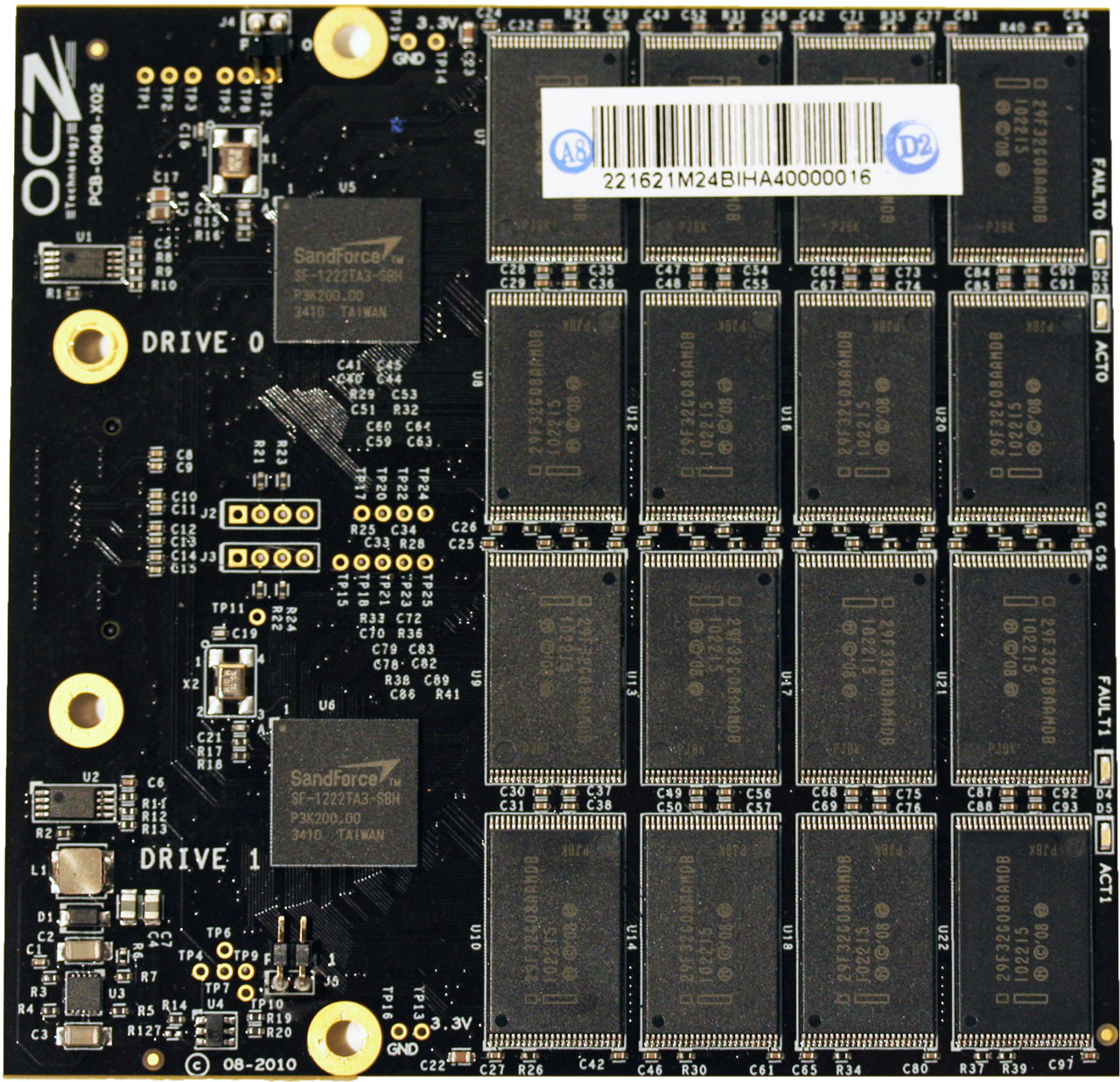OCZ’s RevoDrive X2: When A Fast PCIe SSD Isn’t Fast Enough
In a storage market where it's easiest to take one vendor's controller, another vendor's NAND flash, and put the two in a standard 2.5" SATA drive, OCZ continues innovating, giving IT professionals and power users more performance with its RevoDrive X2.
OCZ’s RevoDrive Is Born
The original RevoDrive is composed of a pair of SandForce SF-1200 controllers mated to Intel NAND flash memory. The SandForce chips are each attached to a Silicon Image Sil3124 four-port SATA controller to create the equivalent of a RAID 0 configuration. And a Pericom bridge chip in its “reverse” configuration converts the four-lane physical PCIe connection into PCI-X for the storage controller.
OCZ’s approach is not particularly elegant, but it is economically viable enough to make the RevoDrive an enthusiast-ready product. The PCI-X controller and bridge chip apparently don’t add much additional cost to the equation, and that’s why a RevoDrive sells for roughly the same price you’d pay for a pair of SandForce-driven Vertex 2 drives creating the same capacity. Naturally, the individual SSDs don’t use additional controllers or bridges—the price of those gets absorbed.
At the same time, OCZ is using components that won’t limit the RevoDrive’s performance. Although the Pericom bridge chip is limited to PCIe 1.1 data rates, that’s still 1 GB/s of bidirectional bandwidth on a four-lane link—more than enough for the device’s claimed 540 MB/s sequential transfer rate. And each of the Sil3124’s ports is SATA 3Gb/s-capable. Again, that’s plenty for each SF-1200 controller. Each step of the way, the company takes care to prevent bottlenecks.
RevoDrive X2: The Secret Everyone Already Knew
With its RevoDrive X2, OCZ clips a daughter board onto the original offering, adding two more SandForce controllers and the potential for twice as much NAND flash. This was probably an eventuality—after all, the original RevoDrive was already using a four-port controller. The RevoDrive X2 simply exploits the hardware’s potential.
The resulting configurations are exactly what you’d expect from doubling the RevoDrive’s capabilities. Capacities jump from 50-480 GB up to 100-960 GB. Performance scales as well, though it doesn’t multiply (we don’t expect it to). And prices, predictably, are quite a bit higher. Whereas a 240 GB RevoDrive sells for $500, the 240 GB RevoDrive X2 will set you back around $650.
Now, the second-gen RevoDrive is still less expensive than the original 240 GB version was at launch. But that doesn’t make it affordable, especially in light of the competitive landscape peppered with fast SandForce-based 2.5” SSDs. Perhaps the most we could hope for here is a PCIe-enabled device priced to match a quartet of individual drives. Instead, you pay a moderate premium for the fact that the X2 puts the equivalent of four drives onto a single card.
Get Tom's Hardware's best news and in-depth reviews, straight to your inbox.
| Header Cell - Column 0 | Capacity | Street Price | Price/GB |
|---|---|---|---|
| OCZ RevoDrive X2 240 GB | 240 GB | $654 | $2.72/GB |
| OCZ RevoDrive 240 GB | 240 GB | $499 | $2.07/GB |
| OCZ Vertex 2 60 GB x 4 | 240 GB | $499 | $2.07/GB |
| Intel X25-M 120 GB x 2 | 240 GB | $478 | $1.99/GB |
Current page: OCZ’s RevoDrive Is Born
Prev Page Meet OCZ's RevoDrive X2 Next Page Test Setup And Benchmarks-
eklipz330 although i think sandforce's new controller won't be as fast as they claim, i really think it's gonna change the face of the ssd race by the end of the yearReply
and probably a new iteration of the revodrive as well... can't wait!! =D =D i need me a 160gb for less than $1/gb... that's how much i bought my raptor for like 4 years ago!! -
cmi86 Yeah its really cool and i wish i had 1...or 2 lol but it just costs waay too much money, isnt really practical for enthusiast use until the prices dropReply -
dirtmountain You routinely use $500 graphic cards (GTX580) and $1,200 displays (2560x1600)in reviews. The price for this upgrade ($650)isn't any harder to stomach then those.Reply -
cangelini dirtmountainYou routinely use $500 graphic cards (GTX580) and $1,200 displays (2560x1600)in reviews. The price for this upgrade ($650)isn't any harder to stomach then those.Reply
Aye, but it's a little less tangible than exotic graphics configurations, too. -
alidan i realy wish they would put a 7200 10000 and 15000 drive in there, all top of their respective class, just so we can get some prospective of how much an improvement these are over traditional hdds.Reply


